
|
|
|
|
The environment has been dramatically difficult to live for amphibian. As the matter of fact, 165 of amphibian species are believed to be extinct, and 50% of 6000 described amphibian species are on the verge of extinction. (1)
Amphibian Ark was leading zoos, aquariums and botanical gardens to initiate the campaign to protect amphibian and announced "2008 – The Year of Frog".
The main goal of the campaign was to generate public awareness and understanding of the amphibian extinction crisis which represents the greatest species conservation challenge in the history of humanity. (2)
| (1) | http://www.amphibianark.org/statistics.htm |
| (2) | http://www.amphibianark.org/yearofthefrog.htm |
Four institutions (Ueno Zoo, Tama Zoo, Inokashira Zoo and Kasai Rinkai Aquarium) in Tokyo took part in the campaign.
Jack visited the three zoos in Tokyo to find how they participated for the campaign.
- INDEX -
| Ueno Zoo | Tama Zoo | Inokashira Park Zoo |
(Februaly 8, 2008)
UENO ZOO

Today, Jack the Lizard visited Ueno Zoo to find out what the zoo has started to protect amphibians.
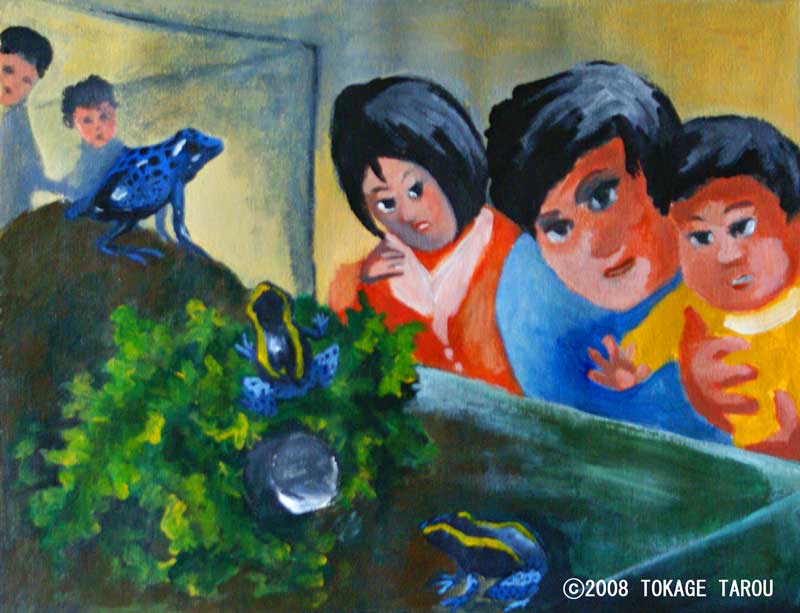
What is the serious threat?
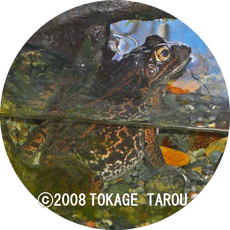 Batrachochytrium dendrobatidis (hereafter Bd), a type of chytrid fungi, was found in 1999. Bd infects amphibians and causes the fatal disease, chytridiomycosis. Since Bd is discovered, the number of amphibian has been dramatically decreasing. For example, 8 Australian indigenous frogs have been already extinct.
Batrachochytrium dendrobatidis (hereafter Bd), a type of chytrid fungi, was found in 1999. Bd infects amphibians and causes the fatal disease, chytridiomycosis. Since Bd is discovered, the number of amphibian has been dramatically decreasing. For example, 8 Australian indigenous frogs have been already extinct.

Bd was found in Japan in December 2006 from a frog in captivity. It is critically important not to spread Bd to the wild. To prevent Bd from spreading, it is very important to keep your pet frogs clean and sterilize its’ tank. If your pet frog was dead, the body must be burnt. Never bury a dead one in soil outside. It is essentially important to protect Japanese native frog species.
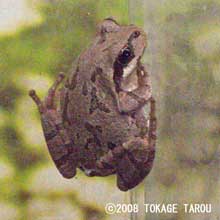
|
They are everywhere, aren't they?Ueno Zoo has about 50 different amphibian species now. Most of them are exotic frogs and newts from other countries. To participate The Year of Frog, the zoo focuses on the Japanese indigenous. Generally speaking, it was assumed that the frogs are commonly everywhere. Therefore rearing Japanese frogs in zoo is quite new project. First, the project team started collecting Tokyo Daruma Pond Frog (Rana Porosa) and Tokyo Salamander (Hynobius tokyoensis). The members went to the upper Tama River in Itsukaichi city in May. Collecting specimens was not easy. You cannot collect the eggs are connected to each other, not suitable for collection because their genes are similar. It is hard to catch dult frogs because they auickly jump to escape. So the numbers of the tadpoles were collected from different mass of eggs. |
Let’s take care of the frogs. We need to know how.
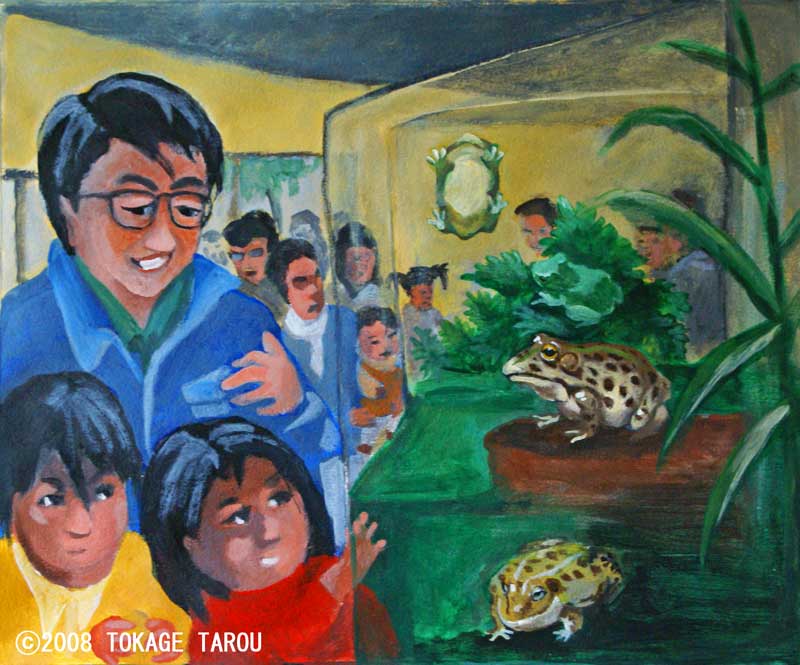
Takahashi explains us about Tokyo Daruma Pond Frog
"We still don’t know exactly how much space is necessary for a pair of frogs. It's not easy to give them a big space in the zoo facility. If it is too small, the frogs would hurt each other", said Takahashi, Manager of amphibian pavilion. Saito, a zookeeper, said, "Tokyo Daruma Pond Frog, a kind of True Frog, has strong power to jump. Unfortunately they don't recognize the glass of tank. When they panic, sometimes they collide with the glass and get hurt themselves." He pointed out the difference of the way to take care of frogs compare to Axolotl and Kasumi Salamander (Hynobius nebulosus) which do not move a lot.

600,000 crickets are in the cases here. They are the food of amphibians and reptiles.

In captivity, the temperature and humidity is adjusted to make the frogs hibernated. Their hibernation affects their breeding in the next spring. “It is a interesting experience as a zookeeper to change their environment to start and end their hibernation”, said Saito.
We may need 6 years at least to understand the frogs’ behaviour in captivity”, said Takahashi. He thinks the breeding experience will help to keep other species such as Kajika Frog (Buergeria Buergeri) and Tago Frog (Rana Tagoi) in the captivity.
After 2008, Ueno Zoo keeps researching about frogs to protect them from Bd.
Can you tell what they are thinking?
If all the amphibians disappear fro the planet, what would be possible to happen? This is not an easy question to answer. Many of you may not mind the extinction of slimy species. The official web site of Amphibian Ark states that Amphibians are indicators of environmental health, important components of ecosystems.

Saito feeds Japanese Giant Salamander. Keeper's Talk is very popular.
Takahashi wants many people to get interested in the world of amphibian.
"Do they look gross? That’s fine. It's welcomed that at least people pay attention to their existence and have curiosity about them."
Tahakashi has loved frogs and rare some by himself when he was a child.
"Frog does not have any facial expression like mammal. I cannot tell what they think, but it is really fun to study about their behaviour. They are such little creatures, but have a complex world where they catch the pray to survive and lay little eggs for the future."
Takahashi sometimes hold lectures to introduce the ecology of amphibians at public high schools.
Beautiful Amphibian
 While amphibian glows, it metamorphoses from breathing with gill to pulmonary respiration. Frog loses its tail while four legs grow.
While amphibian glows, it metamorphoses from breathing with gill to pulmonary respiration. Frog loses its tail while four legs grow.
Axolotl is cannibalistic habit. Even in the captivity, an axolotl may get bit by its fellow and looses a leg. Believe or not, a new leg grow and the axolotl will regain the perfect body.

The ideal temperature for Axolotl is around 20 degrees.
Aince amphibian is our alive textbook to understand the biological evolution, so they are precious species. They've existed since the dinosaur's era. People also love frogs because of their vivid colour.
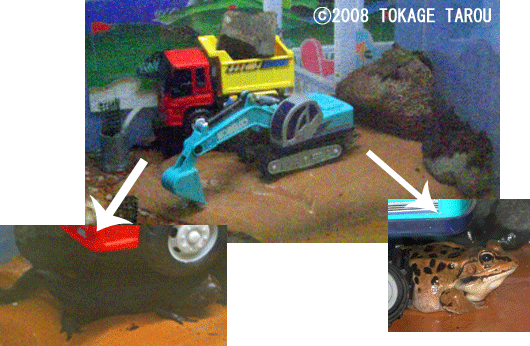
While towns are getting developed, habitats of amphibian are disappearing.
There are so many things that we don't know yet. That's the wonder world of amphibian that we do not want to loose.
(March 4, 2008)
Tama Zoo
Frongs the species the World cares.
Tama Zoo has participated the conservation program, 2008 – Year of the Frog. The zoo shares the information on Batrachochytrium dendrobatidis found in the country, establishes the method of rearing frogs and communicate with other zoos, which take part in the Year of the Frog program.
|
Batrachochytrium dendrobatidis (hereafter Bd), a type of chytrid fungi, was found in 1999. Bd infects amphibians and causes the fatal disease, chytridiomycosis. Since Bd is discovered, the number of amphibian has been dramatically decreasing. For example, 8 Australian indigenous frogs have been already extinct. Bd was found in Japan in December 2006 from a frog in captivity. It is critically important not to spread Bd to the wild. To prevent Bd from spreading, it is very important to keep your pet frogs clean and sterilize its’ tank. If your pdt prog was dead, the body must be burnt. Never bury a dead one in soil outside. It is essentially important to protect Japanese native frog species. |
Tomita, Chief manager of the wild life conservation centre, joined the IUCN World Conservation Congress in Hungary in August 2008.

|
"The conference was carried on in friendly feeling, although, all the participants were highly aware of the fact that the environment around frogs and other amphibians was critically severe", said Tomita. He created "The Map – I found frog in Tokyo!" His maps are found in Tama Zoo, Ueno Zoo, Inokashira Zoo, and Kasai Rinkai Aquarium. Zoo visitors mark red dots on the map at the location where frogs were seen. "You may not see any frogs in your neighbourhood. This map helps you to realize that there are quite a lot of frogs live in Tokyo." Tomita smiled at the zoo visitors who are interested in his map. |
To rear and breedTama Zoo is located in Tama Area where a lot of habitats still remain for wild creatures suburb of Tokyo. To participate the program of 2008 Year of the Frog, the zoo started protection of the Montane Brown Frog, which is endemic to Japan. The wild frogs live in Tama area, including the zoo site. It was not hard to collect them, but rearing was another story. First of all, veterinarians checked each frog was not affected by Bd. Then each frog spent a few weeks in medicated bath. It is very important that they have to be in quarantine not to get mixed with others from outside. The program has just started at Tama Zoo, so these frogs are not on display yet. 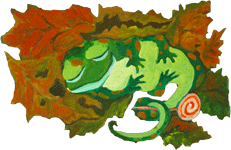
|
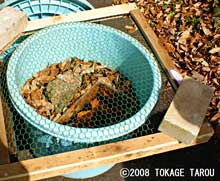
|
|
The Montane Brown Frogs are hibernating in the pail |
|
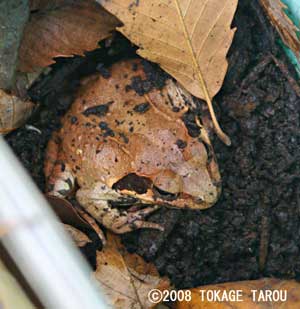
|
|
|
Makimura removed leaves to show me the frog. Do you see it? It's a the Mantane Brown Frog, looks so sleepy. |
Looks dead? No, he has been hibernating.
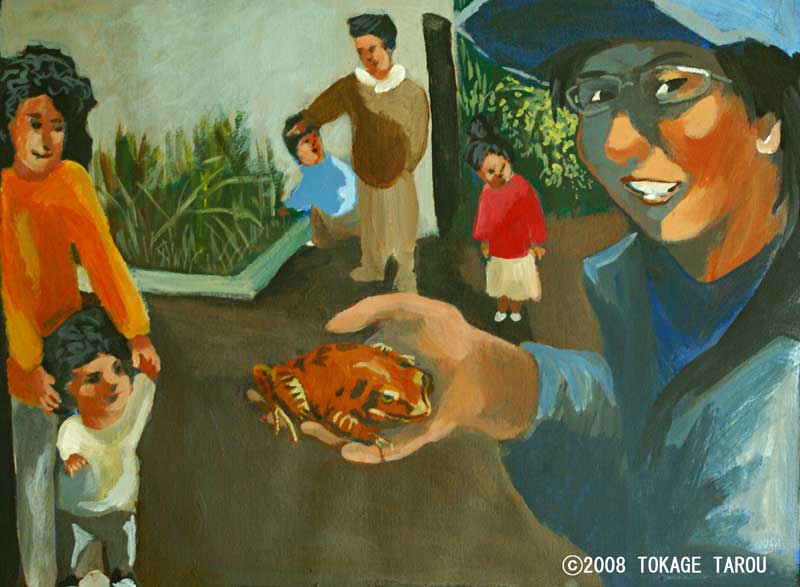
|
Sayoko Makimura is the zookeeper of the five adult Montane Brown Frogs and their tadpoles. At a little pond in the zoo, she told me there were a lot of tadpoles. “The wild Montane Brown Frogs came in and left their eggs in here. They are todpoles now. The water is not clear because of algae, which the tadpoles eat to grow up.” Even for Makimura, there are so many unknown things about the Montane Brown Frog’s biology and ecology. “We stopped to feed the adult frog to have them hibernate last December. I see them changing their position slowly, but normally they don’t move at all”, said Makimura. |

Pond in Tama Zoo. Water looks dirty though... |

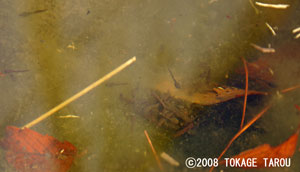
Look in the pond. There are many tadpoles. |
Predetors have been having hard time.
|
Frogs are good meal to water birds such as ibis and heron. Aquatic insects also eat frogs. Unfortunately aquatic insects have been disappearing. Especially the population of the Giant Water Bug (the Lethocerus Deyrollei) is decreasing rapidly in the country. The main reasons would be pesticide, and disappearing rice field. Now it is very rare to find the Giant Water Bugs in Tokyo and its vicinity. Tama Zoo rears and breeds the Predaceous Diving Beetle (the Dytiscidae), the Water Stick Insect (Ranatra) and the Giant Water Bug. The zookeeper, Ryohei Watanabe showed me the Giant Water Bugs. |

|
|
The offspring and full-grown bugs are in the boxes, which are kept in the daytime condition to bread. Each are separated because they are cannibalistic. Watanabe said that the Giant Water Bug eats frogs, tadpoles, small shrimps, killifish, and so on. It is very interesting that he sees each of the Giant Water Bug has different personality when they eat. Even though the Giant Water Bug is an aquatic insect, it could be drowned by overweight after eating too much. |

The srimp is the favourite food of this Giant Water Bug? |
|
I asked Watanabe about the Giant Water Bug and frogs. He said that nobody knows how the natural environment may change because of dissapearing the Giant Water Bug. “The Giant Water Bug is at the top of the food chain at ecology around rice field. If frogs disappear, the Giant Water Bug will also disappear. The ecology is loosing its balance.” It is also said that the population of mosquitoes may grow after disappearing frogs, which eat mosquitoes and larvae. |

The Giant Water Bugs are separated from each other in the containers. |
Let's get to know about the nature around us.
Tama Zoo celebrates its 50th anniversary in 2008. Since it opened, the zoo has committed breading the Crested Ibis. Not only about Year of the Frog, the year 2008 is a very busy year for celebrations and commemoration about animals at Tama Zoo.

(March 4, 2008)
Inokashira Park Zoo
The domestic frogs have been already here.
 All kinds of fresh water fish, amphibians and aquatic insects are exhibited in the Aquatic Life House of Inokashira Zoo. Inokashira Zoo is specializing in indigenous species of Japan. The zoo has joined the program 2008 – Year of the Frog to protect domestic frogs, but conservation of the frogs is not the new project for Inokahira Zoo.
All kinds of fresh water fish, amphibians and aquatic insects are exhibited in the Aquatic Life House of Inokashira Zoo. Inokashira Zoo is specializing in indigenous species of Japan. The zoo has joined the program 2008 – Year of the Frog to protect domestic frogs, but conservation of the frogs is not the new project for Inokahira Zoo.
Unfortunately in Tokyo, local amphibians are diminishing. The sewage from the drain contaminates their habitats. Wetlands are disappearing by expanding residential area. The zookeeper, Hiroshi Arai also pointed out another reason of disappearing aquatic creatures. that brooks and streams which connect to wetlands and small ponds are cut off.
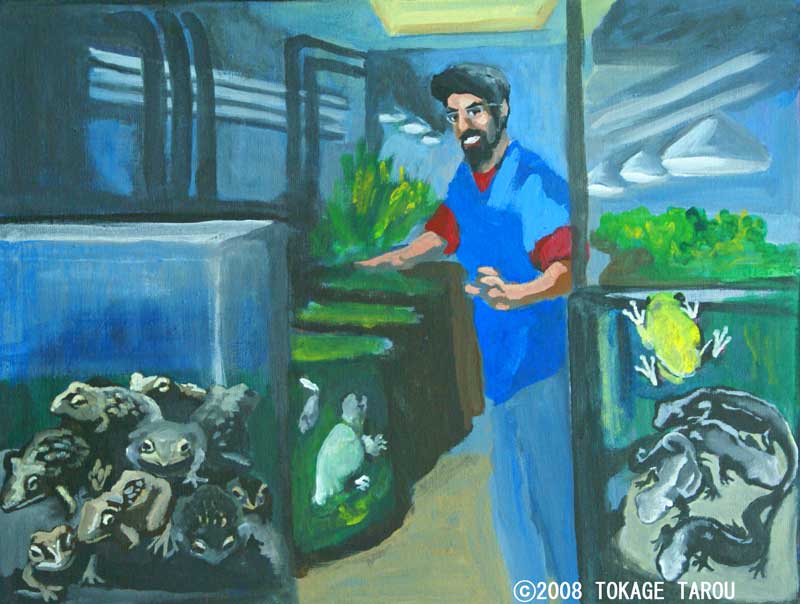
“Frog, amphibian and water insect move to another place for mating, laying eggs or looking for more suitable habitat. But it is very hard for them to move from one wetland to another”, said he.
Could frog be drowned?
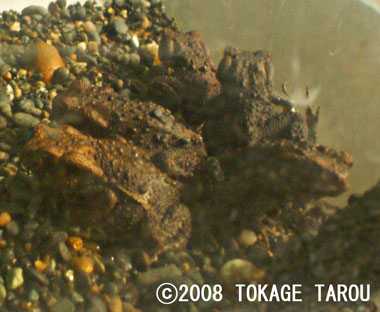 To participate the project of 2008 – Year of the Frog, Inokashira Zoo has been breeding and rearing the Wrinkled Frog (Glendirana rugosa) and the Japanese Fire Belly Newt (Cynops pyrrhogaster).
To participate the project of 2008 – Year of the Frog, Inokashira Zoo has been breeding and rearing the Wrinkled Frog (Glendirana rugosa) and the Japanese Fire Belly Newt (Cynops pyrrhogaster).
The Wrinkled Frog is easier to rear in a captivity because they don’t take a big jump. The zoo has more than 200 frogs, which have left water to land after growing legs from tadpoles.
The Eastern-Japanese Common Toad (Bufo japonicus formosus) is also bred in the zoo. The frog is quite common in this local area, but it is not easy to rear it in captivity. The frog needs both water and land, but young frog could be drowned if you fill water too much. So zookeepers are always careful about the population of frogs and how fast they grow in the tank.
Inokashira Zoo breeds and rears the Japanese Fire Belly Newt with corporation by Kasai Rinkai Aquarium. This newt used to be able to be found even in downtown Tokyo, but it is only found in suburb area now. Even though it is not endangered species yet, the zoo wants visitors to discovere the fascinating newt.
The hungry frog is the super star.

|
The zoo also displays the Forest Green Tree Frog (Rhacophorus arboreus), The Japanese Tree Frog (Hyla japonica) and others are exhibited. Among them, the American Bullfrog is very popular. His large body catches the visitors’ eyes. He was found in a residence nearby. He had a big boil when he came to the zoo. The boil made him decline his appetite. So, he was treated and very healthy then. He has a hearty appetite and sometimes he eats too much. He eats a whole mouse sometimes otherwise he gets slimmed down. Crayfish is his daily meal in the zoo. If you are lucky, you can see him devouring crayfish with his tongue. |
Stop and take a look. They are very rare now!
The Aquatic Life House of Inokashira Zoo has more. The Miyatanago (Tanakia tanago) is the national natural treasure. The Musashitomino is the little fish, which is endemic to Kumagaya city in Saitama. Maybe because they are little and hiding behind water plants, people easily pass by the tank. The zookeepers relocate the water plants and stones or change the light effect to get the visitors attention to the very rare fish.

The zookeeper Arai, who has been the specialist of the aquatic animals, said, “I hope that the campaign of 2008 – Year of the Frog would generate the public awareness about the severe environment damage around frog and amphibian.”
Inokashira Zoo has held special exhibitions and events related to Year of the Frog in 2008.